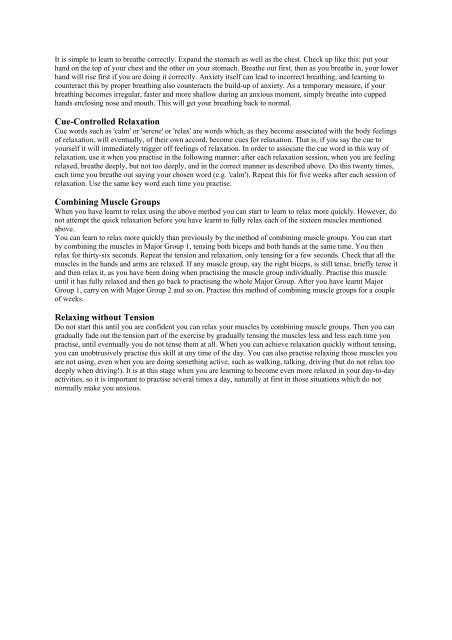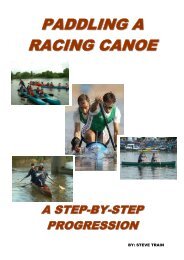The Science of Canoeing By Richard Cox
The Science of Canoeing By Richard Cox
The Science of Canoeing By Richard Cox
You also want an ePaper? Increase the reach of your titles
YUMPU automatically turns print PDFs into web optimized ePapers that Google loves.
It is simple to learn to breathe correctly. Expand the stomach as well as the chest. Check up like this: put your<br />
hand on the top <strong>of</strong> your chest and the other on your stomach. Breathe out first, then as you breathe in, your lower<br />
hand will rise first if you are doing it correctly. Anxiety itself can lead to incorrect breathing, and learning to<br />
counteract this by proper breathing also counteracts the build-up <strong>of</strong> anxiety. As a temporary measure, if your<br />
breathing becomes irregular, faster and more shallow during an anxious moment, simply breathe into cupped<br />
hands enclosing nose and mouth. This will get your breathing back to normal.<br />
Cue-Controlled Relaxation<br />
Cue words such as 'calm' or 'serene' or 'relax' are words which, as they become associated with the body feelings<br />
<strong>of</strong> relaxation, will eventually, <strong>of</strong> their own accord, become cues for relaxation. That is, if you say the cue to<br />
yourself it will immediately trigger <strong>of</strong>f feelings <strong>of</strong> relaxation. In order to associate the cue word in this way <strong>of</strong><br />
relaxation, use it when you practise in the following manner: after each relaxation session, when you are feeling<br />
relaxed, breathe deeply, but not too deeply, and in the correct manner as described above. Do this twenty times,<br />
each time you breathe out saying your chosen word (e.g. 'calm'). Repeat this for five weeks after each session <strong>of</strong><br />
relaxation. Use the same key word each time you practise.<br />
Combining Muscle Groups<br />
When you have learnt to relax using the above method you can start to learn to relax more quickly. However, do<br />
not attempt the quick relaxation before you have learnt to fully relax each <strong>of</strong> the sixteen muscles mentioned<br />
above.<br />
You can learn to relax more quickly than previously by the method <strong>of</strong> combining muscle groups. You can start<br />
by combining the muscles in Major Group 1, tensing both biceps and both hands at the same time. You then<br />
relax for thirty-six seconds. Repeat the tension and relaxation, only tensing for a few seconds. Check that all the<br />
muscles in the hands and arms are relaxed. If any muscle group, say the right biceps, is still tense, briefly tense it<br />
and then relax it, as you have been doing when practising the muscle group individually. Practise this muscle<br />
until it has fully relaxed and then go back to practising the whole Major Group. After you have learnt Major<br />
Group 1, carry on with Major Group 2 and so on. Practise this method <strong>of</strong> combining muscle groups for a couple<br />
<strong>of</strong> weeks.<br />
Relaxing without Tension<br />
Do not start this until you are confident you can relax your muscles by combining muscle groups. <strong>The</strong>n you can<br />
gradually fade out the tension part <strong>of</strong> the exercise by gradually tensing the muscles less and less each time you<br />
practise, until eventually you do not tense them at all. When you can achieve relaxation quickly without tensing,<br />
you can unobtrusively practise this skill at any time <strong>of</strong> the day. You can also practise relaxing those muscles you<br />
are not using, even when you are doing something active, such as walking, talking, driving (but do not relax too<br />
deeply when driving!). It is at this stage when you are learning to become even more relaxed in your day-to-day<br />
activities, so it is important to practise several times a day, naturally at first in those situations which do not<br />
normally make you anxious.



